Melasma, or “pekas,” is a skin condition characterized by the appearance of brown or grayish-brown patches on the face and can be distressing for many people. It is caused by the overproduction of melanin, the pigment that gives our skin its color, and is often associated with hormonal changes or sun exposure. Some people have lived with melasma for most of their lives. Some might be seeking a way out, wanting to regain the flawless skin they once had, and some, having little to no access to expensive treatments, might have just given up hope.
While melasma is not harmful, it can be cosmetically concerning, and many people seek treatment to help fade the patches. From a different perspective, one could say that having “pekas” only affects the person experiencing them if they put much thought into how other people view them when they have their melasma on display. Although, in reality, these dark spots on the skin can make anybody lose confidence, especially in severe cases.
Studies suggest that “pekas” (melasma) leans more toward negatively affecting a person’s mental health than it does physically. Pekas is not known to cause any harm to a person’s skin health, aside from the appearance of dark spots. So how do we cure melasma? What are the medicines for pekas? In this article, we will discuss some effective ways to treat melasma.
What is pekas?
Pekas or melasma is a skin condition that affects areas of the face, neck, and/or shoulders. It appears as dark spots on the skin and predominantly occurs in adult women—especially pregnant women—and is also common to dark-skinned races, like Asians and Hispanics.
Pekas is usually diagnosed if it consists of hypermelanosis in either of the three facial patterns:
Centrofacial: Most melasma cases have patterns on the forehead, nose, and upper lip, excluding the cheeks and chin, and these cases are called centrofacial patterns.
Malar: Patterns that form on the upper cheek or below the eyes are known as malar patterns.
Mandibular: Lastly, dark spots present in the jaw area and chin are mandibular melasma.
In some cases, melasma can also appear on other body parts, such as the shoulders, neck, forearms, and upper extremities, and these have been dubbed “extra facial melasma.”
Medicine for pekas
Finding treatments for any skin problem can be daunting, especially since people have different skin types and react to different ingredients. For pekas, however, there is Pynocare. Pynocare is the only FDA-approved oral medicine for pekas. Pynocare is clinically proven to reduce the appearance of pekas in as fast as 8 weeks. Studies have also shown that Pynocare produces the best results when taken twice daily for 8 to 12 weeks. The best thing is that it produces little to no side effects.
So how does Pynocare work? The answer lies in its formulation. It is composed of clinically proven and tested ingredients that target the cellular cause of the hyperpigmentation.
Beta-carotene (Vitamin A). Beta-carotene is a precursor to vitamin A, meaning beta-carotene is readily transformed in the body into vitamin A. It is supplied as D. salina extract, a natural and rich source of beta-carotene with strong antioxidant activity. Beta-carotene has been proven through countless studies to reduce dark spots by neutralizing free radicals that can damage cells in the body. A recent study also highlights the role of carotenoids (including beta-carotene) in protecting the skin from environmental factors such as pollution and UV radiation that can greatly affect skin health and appearance.
Ascorbic acid (vitamin C). Oral vitamin C has also been studied as a treatment for hyperpigmentation disorders. Vitamin C is widely used as a depigmentation agent in most cosmetic and beauty products. When taken orally, it inhibits the tyrosinase enzyme and melanin, making it an excellent ingredient for melasma treatment. Vitamin C also has strong antioxidant activity and anti-inflammatory properties.
d-alpha-Tocopheryl Acetate (vitamin E). This ingredient is helpful in helping protect the skin from UV ray sun damage, which is one of the proposed causes of melasma. Vitamin E is also a potent antioxidant that stops the production of reactive oxygen species (ROS), which are known to accelerate skin aging and inflammation. Moreover, studies suggest that vitamin E in combination with vitamin C has shown better protection from UV ray damage.
Procyanidin: Procyanidin has antioxidant and anti-inflammatory properties, making it a promising option for treating melasma. It is several times more potent than vitamins C and E as antioxidants. Several studies have been conducted to establish its safety and efficacy, especially in hyperpigmentation disorders. Working in combination with the other components, procyanidin and vitamins A, C, and E are proven to be effective in treating melasma.
Other options for treating melasma
Treating melasma requires a visit to a dermatologist to create a treatment plan fit for your needs. Your dermatologist may look at your skin tone, the depth of melasma, possible triggers, and risk factors. These treatment plans may include some of the following:
UV rays and sun protection. It is known that sunlight contributes to the skin’s hyperpigmentation, which can cause melasma to flare, darken existing spots, and create new ones. Sun protection is the most crucial step to melasma treatment, so it is advisable to protect the skin from the harmful rays of the sun by using broad-spectrum sunscreen with an SPF of 30 or higher.
Dermatologists suggest using sunscreen that contains the following ingredients: zinc oxide, titanium dioxide, and iron oxide.
Topical agents. There are several topical treatments available for melasma. Hydroquinone is a commonly used medication that works by blocking the production of melanin. It is available over-the-counter in concentrations of up to 2%, and higher concentrations require a prescription. Other topical treatments include azelaic acid, kojic acid, and retinoids, which can also help fade the patches. These medications should be used under the guidance of a dermatologist, as they may cause irritation or other side effects.
Chemical peels and laser therapy. Chemical peels can help improve the appearance of melasma by removing the outer layers of skin that contain the excess pigment. There are several types of chemical peels available, ranging from mild to deep. Mild peels can be done at home using over-the-counter products, while deeper peels should be done by a dermatologist. Chemical peels may cause redness, peeling, and sensitivity to the sun, so it is important to follow the dermatologist’s instructions for aftercare.
Laser therapy, on the other hand, works by targeting the excess pigment in the skin and breaking it down so that it can be absorbed by the body. Several sessions may be required for the best results, and there may be some temporary redness or swelling after each session. Both of these options can be expensive and have a lot of downtime due to their side effects.
Combination therapy. Often, dermatologists would suggest a combination of one or two of these treatment options. For example, they might prescribe an oral medicine for pekas alongside topical agents. Similarly, they could do a chemical peel or laser therapy to accelerate the depigmentation process, then prescribe oral and topical agents for maintenance.
Can pekas be prevented?
Unfortunately, people who are likely to develop this condition can only do so much to prevent it from happening. Pekas is caused by an interplay of genetics, skin color, skin type, hormones, high levels of sun exposure and even environmental and lifestyle factors. The best one could do is to avoid or limit their exposure to these risk factors, like avoiding unnecessary sun exposure and using harsh ingredients in their skincare regimen.
Another thing about pekas is its risk of recurrence. Pynocare can be used as a preventive measure for people who are at risk of developing melasma again. This makes Pynocare not only a medicine for pekas but also a preventive agent for it. The recommended dosage for maintenance is 1 capsule a day. With the right treatment, melasma can be effectively managed, and the appearance of the patches can be significantly improved.
References
- Balić, A., & Mokos, M. (2019). Do We Utilize Our Knowledge of the Skin Protective Effects of Carotenoids Enough?. Antioxidants (Basel, Switzerland), 8(8), 259. https://doi.org/10.3390/antiox8080259
- Ogbechie-Godec, O. A., & Elbuluk, N. (2017). Melasma: an Up-to-Date Comprehensive Review.
- Dermatology and Therapy, 7(3), 305–318. https://doi.org/10.1007/s13555-017-0194-1 https://www.aad.org/public/diseases/a-z/melasma-treatment
- https://jddonline.com/articles/the-therapeutic-use-of-antioxidants-for-melasma-S1545961620P0788X
————————————————————————————————————————————————————————————–
PYNOCARE (Procyanidin + Ascorbic Acid + Betacarotene + d-Alpha-Tocopheryl Acetate)
The first and only oral medicine that is clinically proven to reduce Melasma or dark spots formation in just 8 weeks. Unlike creams, lotions, and gels, it has MSCC or Melasma Skin Clear Complexion Complex formulation that deeply penetrates the inner layers of the skin, to help normalize melanin levels, thus minimizing the appearance of dark spots in a short time.
Mega Lifesciences Limited Inc. or Mega We Care, is actively involved in helping millions of people have access to safe, effective, world-class quality nutritional & herbal supplements, OTC, and ethical products.

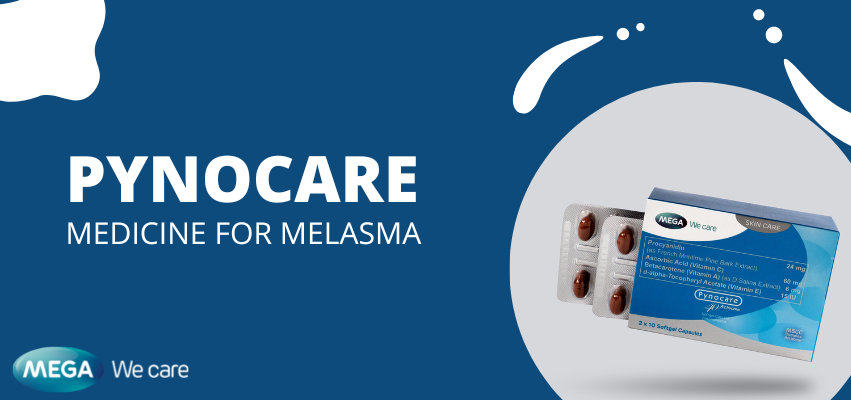
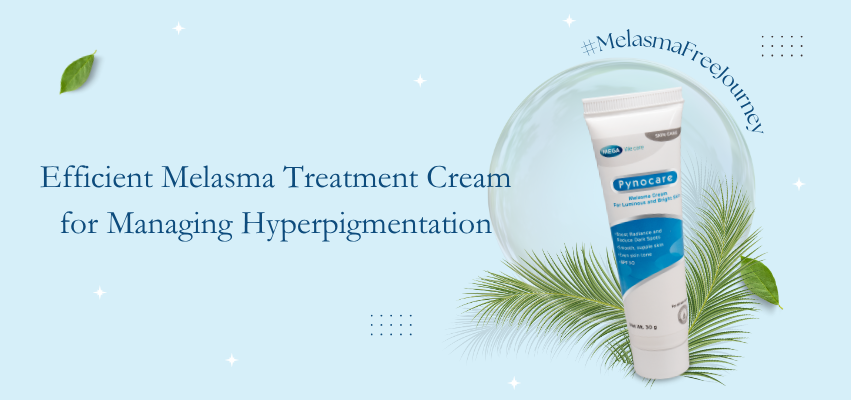
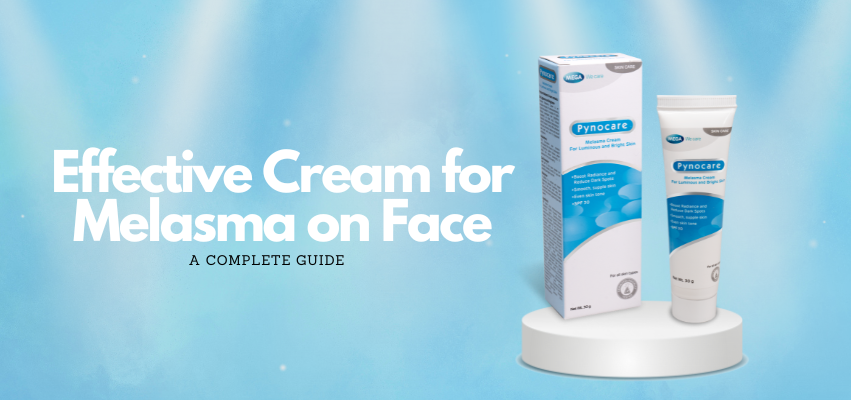
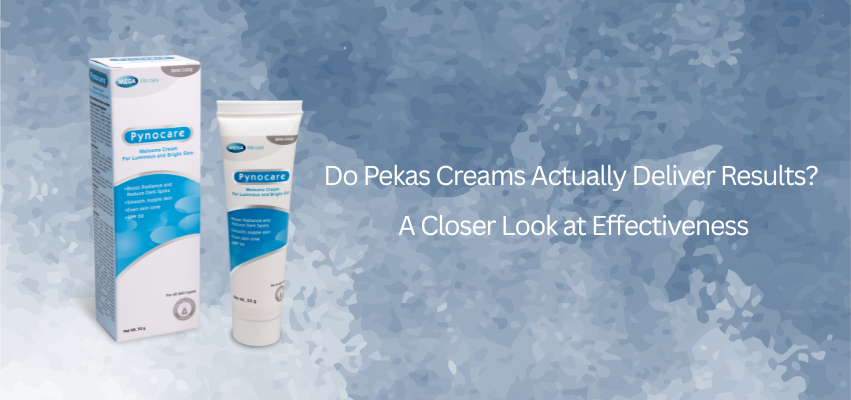


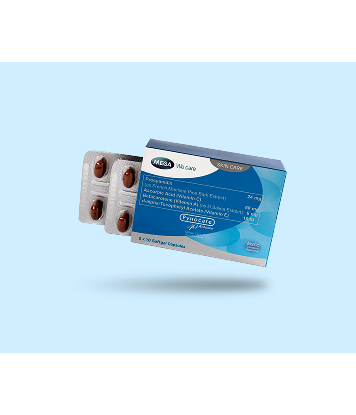













No Comments on Medicine for Pekas